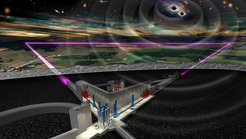Einstein Telescope
The Einstein Telescope (ET) is a design concept for a European third-generation gravitational-wave detector, which will be 10 times more sensitive than the current advanced instruments of the second generation.
Three detector generations

Like the first two generations of gravitational-wave detectors, the concept for the Einstein Telescope is based on the measurement of tiny changes (far less than the size of an atomic nucleus) in the lengths of two connected arms several kilometres long, caused by a passing gravitational wave. Laser beams in the arms record their periodic stretching and shrinking via brightness changes on a central photodetector.
The first generation of these interferometric detectors (GEO600, LIGO, Virgo and TAMA) successfully demonstrated the proof-of-principle and constrained the expected gravitational-wave emission from several sources. The next generation (Advanced LIGO and Advanced Virgo), which were constructed until 2015, have made the first direct detection of gravitational waves and have observed 90 signals so far. However, these detectors will not be sensitive enough for very precise astronomical studies of the gravitational-wave sources – new detectors are required.
A multi-detector
The strategy behind the Einstein Telescope project is to build an observatory that overcomes the limitations of current detector sites by hosting more than a single gravitational-wave detector. It will consist of three nested detectors, each composed of two interferometers with arms 10 kilometres long. One interferometer will detect low-frequency gravitational wave signals (2 to 40 Hz), while the other will detect the high-frequency components. The configuration is designed to allow the observatory to evolve by accommodating successive upgrades or replacement components that can take advantage of future developments in interferometry and also respond to a variety of science objectives.
Currently, possible detector sites in the border area of Belgium, Germany, and the Netherlands as well as Sardinia and Lusatia are being evaluated.
The role of the institute in the Einstein Telescope project
The Max Planck Institute for Gravitational Physics (Albert Einstein Institute, AEI) with locations in Potsdam and Hannover, has long been a leading institution in gravitational-wave research and is a co-initiator of the Einstein Telescope. Researchers at the institute hold leading positions within the project and the Einstein Telescope Scientific Collaboration. Harald Lück is the deputy spokesperson of the Einstein Telescope Scientific Collaboration.
Main Einstein Telescope research areas at the institute in Hannover:
- The development and testing of a laser source for the ETpathfinder in Maastricht and for the Einstein Telescope, the generation of squeezed light and its use, and the active suppression of seismic effects on ET's mirror suspensions.
- The 10 meter interferometer prototype in Hannover is a test bed for new technologies to be used in future interferometric gravitational-wave detectors.
- The “Glass Technologies for the Einstein Telescope” (GT4ET) project with the Fraunhofer Institute for Applied Optics and Precision Engineering is developing miniaturized optomechanics for ET.
Main Einstein Telescope research areas at the institute in Potsdam:
- Theoretical modeling of gravitational-wave sources using analytical and numerical techniques, both for black holes and neutron stars.
- Sophisticated and efficient methods for data analysis to infer the properties of the population of binary systems, the unknown internal structure of neutron stars, and the nature of gravity.
- Investigations of events where signals in the electromagnetic spectrum are expected in addition to gravitational-wave observations (multi-messenger astronomy).







